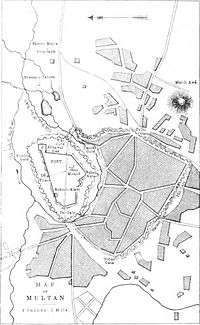Siege of Multan (1818)
The Siege of Multan was a battle between a Vizier of the Durrani Empire and the Sikh Empire that started in March 1818 and ended on 2 June 1818.[3]
Background

After he was defeated at the Battle of Attock, the Durrani Vizier, Fateh Khan, fought off an attempt by Ali Shah, the ruler of Persia, to capture the Durrani province of Herat.[4] He was joined by his brother, Dost Mohammad Khan, and the rogue Sikh Sardar Jai Singh Attarwalia. Once they had captured the city, Fateh Khan attempted to remove the ruler, a relation of his superior, Mahmud Shah, and rule in his stead. In the attempt to take the city from its Durrani ruler, Dost Mohammad Khan's men robbed a princess of her jewels.[5] Kamran Durrani, Mahmud Shah's son, used this as a pretext to remove Fateh Khan from power, and had him horribly tortured and executed.[5]
While in power, however, Fateh Khan had installed twenty-one of his brothers in positions of power throughout the Durrani Empire. After his death the next eldest brother Mohd. Azim Khan, governor of Kashmir, led the Barakzais as they rebelled and divided up the provinces of the empire between themselves. During this turbulent period Kabul had many temporary rulers until Dost Mohammad Khan captured the city in 1826.[6]
The Sikh Empire had attacked Multan multiple times in the past, the largest attack being in 1810. However, on the previous occasions the Sikh forces would defeat the defending force and seize the city only to have the governor of Multan, Muzaffar Khan Sadozai, retreat into the Multan Fort. During previous sieges the Sikhs had settled for large single payments of tribute, while the attack in 1810 resulted in Multan paying a yearly tribute. Muzaffar Khan already ruled the Durrani province of Multan independently of the descendants of Ahmad Shah Abdali, the rulers of Kabul. With the relatives of the deceased Fateh Khan engulfed in a power struggle with Mahmud Shah, no Durrani force would be able to relieve him.
Battle
In early 1818, Ranjit Singh ordered the Sikh army to rendezvous on the south-west frontier of the Sikh Empire to make preparations for an expedition against Multan. By January 1818, the Sikh Empire had established an extensive supply chain from the capital, Lahore, to Multan, with the use of boat transports to ferry supplies across the Jhelum, Chenab, and Ravi rivers.[7] Rani Raj Kaur herself oversaw the steady supply of grain, horses, and ammunition being sent to the at Kot Kamalia, a town equally distanced between Multan and Lahore.[7]
In early January the Sikh force began their campaign with the capture of Nawab Muzaffar Khan's forts at Muzaffargarh and Khangarh. In February, the Sikh force under Kharak Singh reached Multan and ordered Muzaffar to pay the large tribute he owed and to surrender the fort, but Muzaffar refused. The Sikh forces won an engagement near the city but were unable to capture Muzaffar before he retreated into the fort. The Sikh army asked for more artillery and Ranjit Singh sent them the Zamzama and other large artillery pieces, which commenced fire on the walls of the fort. In early June, Sadhu Singh and a small band of other Akalis attacked the fort walls and discovered a breach in the wall. As they ran in to battle the unaware garrison the larger Sikh army was alerted and entered the fort through the breach. Muzaffar and his sons attempted a sortie to defend the fort but were killed in the battle.
The siege of Multan ended significant Afghan influence in the Peshawar region and led to multiple Sikh attempts at capturing and the final capture of Peshawar.
Notes
- Kharak Singh was the nominal leader of the expedition as several officers refused to serve under Dewan Mokham Chand.[1]
References
- Chopra 1928, p. 17
- Chopra 1928, p. 23
- Jaques 2006, p. 696.
- Cunningham 1918, p. 157.
- Cunningham 1918, pp. 152–153.
- Tanner 2009, p. 126.
- Chopra 1928, p. 17.
Bibliography
- Chopra, Gulshan Lall (1928). The Panjab as a Sovereign State. Lahore: Uttar Chand Kapur and Sons.
- Cunningham, Joseph Davey (1918). A history of the Sikhs. London, New york: Oxford University Press.CS1 maint: ref=harv (link)
- Jaques, Tony (2006). Dictionary of Battles and Sieges: A-E. Greenwood Press. ISBN 978-0-313-33537-2. Archived from the original on 2015-06-26.CS1 maint: ref=harv (link)
- Tanner, Stephen (2009). Afghanistan: A Military History from Alexander the Great to the War against the Taliban. Da Capo Press. ISBN 978-0-306-81826-4.CS1 maint: ref=harv (link)
- Chopra, Gulshan Lall (1928). The Panjab as a Sovereign State. Lahore: Uttar Chand Kapur and Sons.CS1 maint: ref=harv (link)
- Prakash, Om (2002-09-01). Encyclopaedic History of Indian Freedom Movement. Anmol Publications PVT. LTD. ISBN 978-81-261-0938-8. Retrieved 31 May 2010.